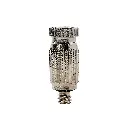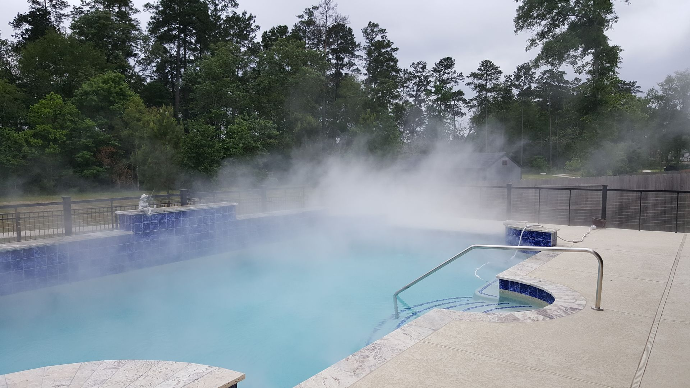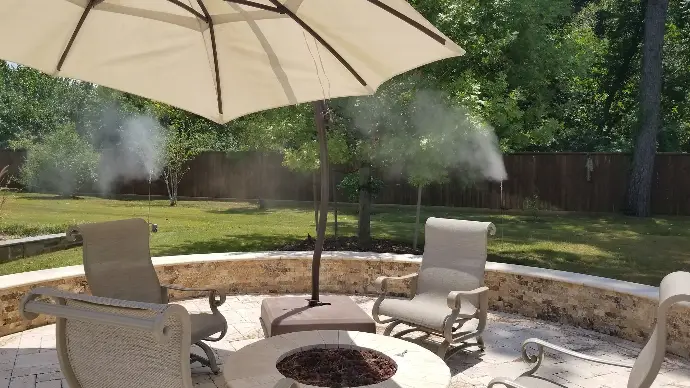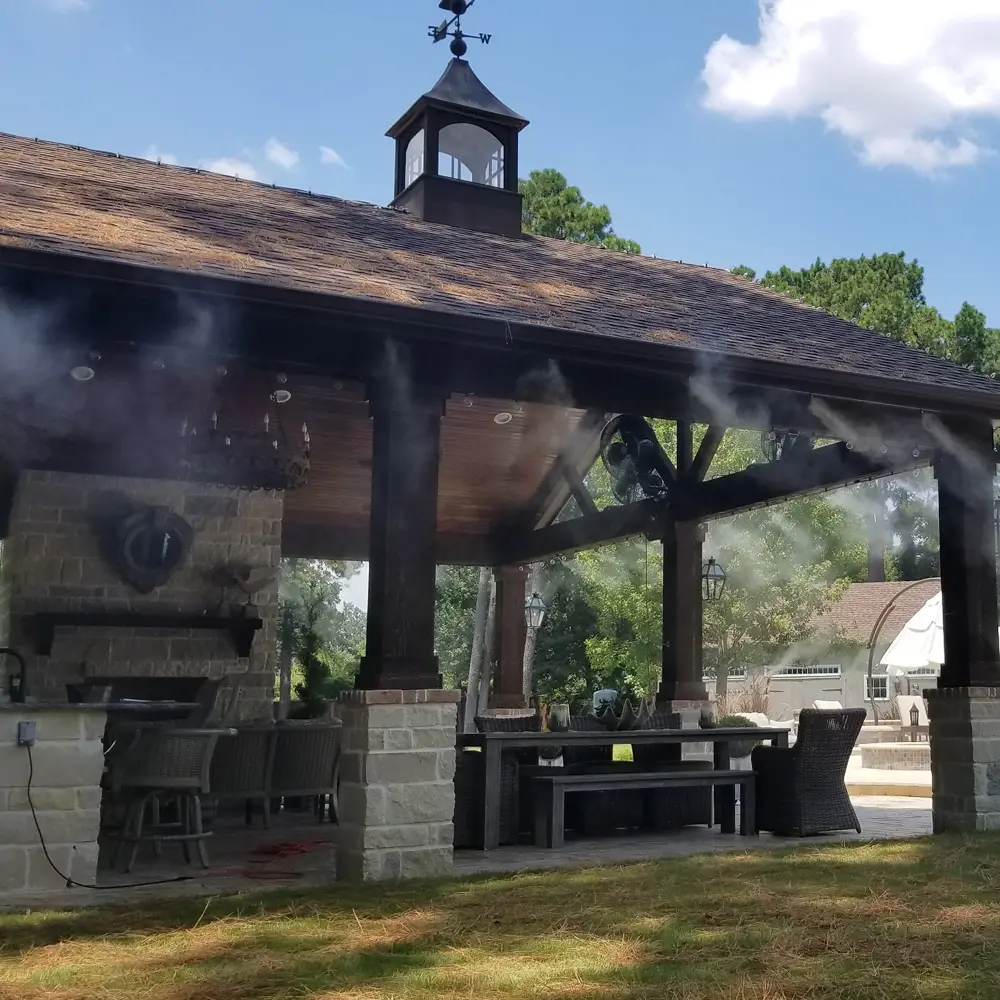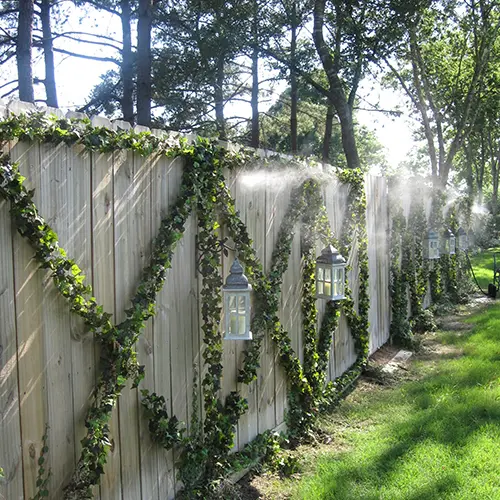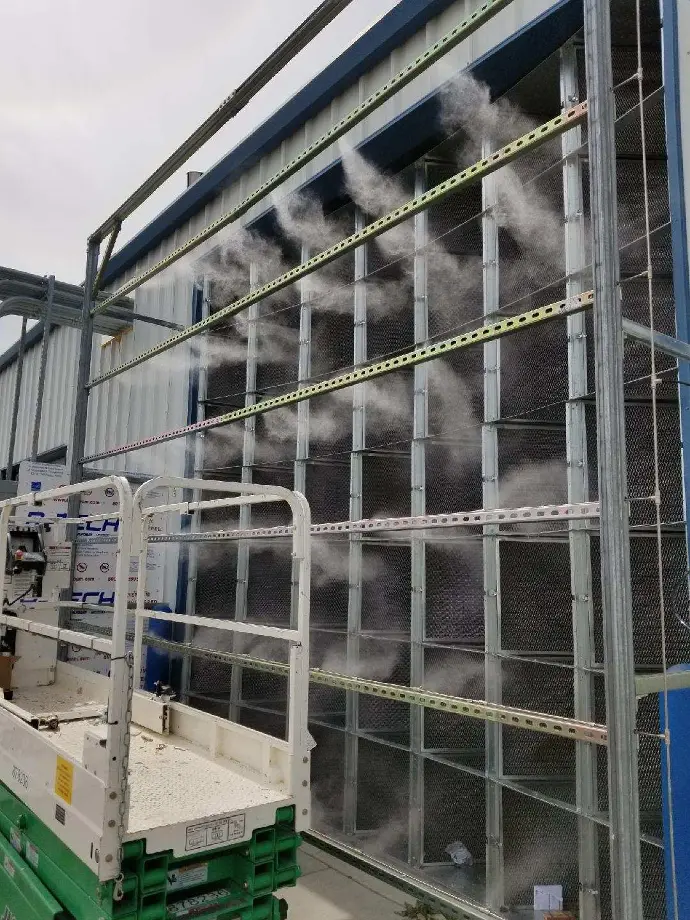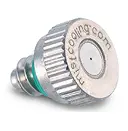
Stainless Steel Misting Nozzles
From SEO to social media, we create campaigns that not only get you noticed but also drive engagement and conversions.555
Brass / Stainless Steel Misting Nozzles
- Stainless Steel misting nozzles excel in versatility, durability, user safety, and easy maintenance, making them the ideal choice for your misting needs.
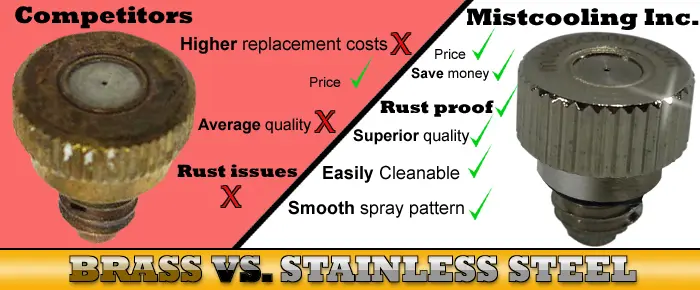
Factor to consider when choosing Misting Nozzles

Water pressure
To determine the appropriate orifice size, consider the following recommendations:
- For low pressure, it is advisable to use a 0.020" or 0.015" orifice.
- For medium pressure, a 0.012" orifice is recommended.
- For high pressure, it is suggested to use a 0.008" or 0.006" orifice.
Placement of the system
Will the misting system be utilized in a residential, restaurant, or industrial environment?For residential applications, we recommend utilizing standard misting nozzles; for restaurant settings, anti-drip nozzles are advised; and for industrial use, specialized nozzles are available.
Nozzle material
Which type of nozzle material is superior - Plastic, Brass, or Stainless Steel?
Materials requirements
Do we require specialized nozzles for specific corrosive applications?
Write something...
Write something...
Applications of Misting Nozzles
Nozzle Flow Rate - GPM - 1000 PSI
Nozzle Flow Rate - GPH - 1000 PSI
Flow Rate for High Flow Misting Nozzles
MistCooling offers a range of high-flow misting nozzles designed to cater to various misting needs. These nozzles are characterized by their ability to provide a larger volume of mist, making them suitable for both residential and industrial applications. Below are the details of the high-flow nozzles available:
Nozzle Sizes:
Nozzle Flow Rate - GPM - 1000 PSI
Nozzle Flow Rate - GPH - 1000 PSI
- 0.040 Inch Orifice (Highest Flow): This nozzle offers the highest flow rate, making it ideal for applications where maximum cooling and misting are required. The larger orifice size allows for greater water throughput, creating a denser mist that covers more area.
- 0.032 Inch Orifice: This nozzle provides a balanced flow, suitable for moderate misting needs. It is perfect for cooling applications that require efficient water use without compromising on mist coverage.
- 0.024 Inch Orifice: This nozzle has a smaller orifice, providing a more controlled mist flow, ideal for areas where water conservation is a priority but adequate cooling is still required.
Threading and Material:
- All these nozzles come with standard 10/24-inch threading, ensuring compatibility with most misting systems.
- They are nickel-plated, offering durability and resistance to corrosion, which is essential for long-term outdoor use.
Applications: These high-flow misting nozzles are versatile and can be used in a variety of settings:
- Residential: Cool misting for gazebos, porches, patios, and other outdoor living spaces.
- Agricultural: Effective for cooling animal enclosures like chicken coups, hog pens, and barns.
- Special Effects: Suitable for creating mist effects in entertainment, spray tanning setups, or brewing processes.
- Industrial: Ideal for corral cooling and other large-scale misting applications where efficient cooling is necessary.
MistCooling's high-flow nozzles are designed to deliver superior performance in any misting system, ensuring optimal cooling and misting for various needs. Whether for residential patios or industrial barns, these nozzles provide the right balance of flow and coverage.
MistCooling offers a range of high-flow misting nozzles designed to cater to various misting needs. These nozzles are characterized by their ability to provide a larger volume of mist, making them suitable for both residential and industrial applications. Below are the details of the high-flow nozzles available:
Nozzle Sizes:
- 0.040 Inch Orifice (Highest Flow): This nozzle offers the highest flow rate, making it ideal for applications where maximum cooling and misting are required. The larger orifice size allows for greater water throughput, creating a denser mist that covers more area.
- 0.032 Inch Orifice: This nozzle provides a balanced flow, suitable for moderate misting needs. It is perfect for cooling applications that require efficient water use without compromising on mist coverage.
- 0.024 Inch Orifice: This nozzle has a smaller orifice, providing a more controlled mist flow, ideal for areas where water conservation is a priority but adequate cooling is still required.
Threading and Material:
- All these nozzles come with standard 10/24-inch threading, ensuring compatibility with most misting systems.
- They are nickel-plated, offering durability and resistance to corrosion, which is essential for long-term outdoor use.
Applications: These high-flow misting nozzles are versatile and can be used in a variety of settings:
- Residential: Cool misting for gazebos, porches, patios, and other outdoor living spaces.
- Agricultural: Effective for cooling animal enclosures like chicken coups, hog pens, and barns.
- Special Effects: Suitable for creating mist effects in entertainment, spray tanning setups, or brewing processes.
- Industrial: Ideal for corral cooling and other large-scale misting applications where efficient cooling is necessary.
MistCooling's high-flow nozzles are designed to deliver superior performance in any misting system, ensuring optimal cooling and misting for various needs. Whether for residential patios or industrial barns, these nozzles provide the right balance of flow and coverage.
M Series Nozzles
M Series Misting Nozzles with 1/8 NPT Thread: Reliable and Versatile
The M Series misting nozzles with a 1/8 NPT (National Pipe Thread) threaded connection offer a secure and durable solution for various misting applications. This standard thread size ensures compatibility with a wide range of pipes and fittings, making installation straightforward and reliable.
Key Features:
- Secure Fit: The 1/8 NPT threading provides a tight seal, reducing leaks and ensuring consistent misting performance.
- Versatile: Compatible with various piping systems, making these nozzles suitable for residential, commercial, and industrial use.
- Durability: Made from high-quality materials like stainless steel or brass, they withstand harsh conditions and high pressure.
- Easy Maintenance: The standard thread size allows for easy removal and replacement, simplifying upkeep.
- Consistent Mist: Precision-engineered to deliver fine mist with optimal flow rates for effective cooling, humidification, and dust suppression.
Nozzle Flow Rate - GPH - 500 psi
Whether for outdoor cooling, industrial dust control, or greenhouse humidification, M Series nozzles with 1/8 NPT threading provide reliable performance and easy integration into any misting system.
KBN Ceramic Nozzles
- Ultra-low flow rate hollow cone spray nozzle with the finest atomization among hydraulic nozzles.
- Minimal clogging with free passage diameter 1.3–2.6 times bigger than that of conventional nozzles.
- High-purity alumina ceramic tip provides stable performance with longer life even under high pressure conditions.
[STANDARD PRESSURE] 145.04 psi
[APPLICATIONS]
- Cooling: Poultry farms, outside cooling
- Humidifying: Air handling units, greenhouses
- Spraying: Alcohol, disinfectant
- Others: Dust suppression, irrigation for greenhouse
[DROPLET SIZE] : 35um - 65um ( Red ----> Purple)
[SPRAY ANGLE CODE] : 80
Structure
- One-piece plastic nozzle molded around a high-purity ceramic orifice.
- Thread is R1/4 (BSPT 1/4 male) or NPT 1/4 male.
- All models include a built-in strainer and check valve.
Material
- Nozzle orifice: ceramic
- Closer: polyester elastomer
- Nozzle body: PA
Weight
- 4 g
Max. operating pressure: 1000 psi
Nozzle Flow Rate - GPH - 1000 psi
Choose the Best Nozzle for You
MISTING NOZZLES FAQ's
What are the different types of misting nozzles available?
- Answer: Misting nozzles are available in various types, including brass/stainless steel nozzles, ceramic nozzles, and anti-drip nozzles. Each type is designed for specific applications and misting needs.
How often should misting nozzles be cleaned?
- Answer: Misting nozzles should be cleaned every 3-6 months to ensure optimal performance. Regular cleaning prevents clogging and maintains a fine mist.
What causes misting nozzles to clog?
- Answer: Misting nozzles can clog due to mineral deposits from hard water, debris, or impurities in the water supply. Using filtered water and regular maintenance can help prevent clogging.
How do I determine the right misting nozzle for my system?
- Answer: Determine the right misting nozzle by considering factors such as the desired misting effect, water pressure, and the area to be covered. Consulting with a misting system expert can also help you make the right choice.
Can misting nozzles be used with low-pressure systems?
- Answer: Yes, certain misting nozzles are designed specifically for low-pressure systems, typically operating at pressures below 250 PSI. However, for finer mist and better cooling, high-pressure nozzles are recommended.
What maintenance is required to keep misting nozzles in good condition?
- Answer: Regular maintenance includes cleaning the nozzles to remove mineral deposits, inspecting for clogs, and replacing any worn or damaged parts. Using filtered water can also reduce maintenance needs.
What material are the misting nozzles made of?
- Answer: Misting nozzles are typically made of brass with stainless steel or ceramic inserts to ensure durability and a fine mist.
Are replacement nozzles available for purchase separately?
- Answer: Yes, replacement nozzles are available for purchase separately. You can find them on the Mistcooling website under the accessories section.
How do I install misting nozzles in my misting system?
- Answer: To install misting nozzles, simply screw them into the designated fittings on the misting line. Ensure they are tightly secured to prevent leaks.
What is the flow rate of the misting nozzles?
- Answer: The flow rate of misting nozzles typically ranges from 0.012 to 0.020 gallons per minute (GPM), depending on the nozzle type and pressure.
Can misting nozzles be used with any misting system?
- Answer: Misting nozzles are generally compatible with most misting systems, but it is important to check the nozzle specifications and threading to ensure compatibility.
Do misting nozzles require special maintenance?
- Answer: Regular maintenance, such as cleaning and inspecting for clogs, is necessary to keep misting nozzles functioning properly. Using water filters can also help reduce maintenance needs.
What is the difference between low-pressure and high-pressure misting nozzles?
- Answer: Low-pressure misting nozzles operate at pressures below 250 PSI and produce larger droplets, while high-pressure nozzles operate at pressures above 500 PSI and produce finer mist for better cooling efficiency.
How do anti-drip misting nozzles work?
- Answer: Anti-drip misting nozzles have a built-in valve that prevents water from dripping when the system is turned off, ensuring a clean and efficient misting operation.
Can misting nozzles be used indoors?
- Answer: Misting nozzles can be used indoors, but it is important to ensure proper ventilation and humidity control to prevent excessive moisture buildup.
What is the recommended water pressure for misting nozzles?
- Answer: The recommended water pressure for misting nozzles varies depending on the type, but high-pressure nozzles typically require 800-1000 PSI for optimal performance.
Are there adjustable misting nozzles available?
- Answer: Yes, adjustable misting nozzles are available that allow you to control the flow rate and spray pattern to suit different cooling needs.
How do I clean clogged misting nozzles?
- Answer: To clean clogged misting nozzles, soak them in a solution of vinegar and water, then use a small brush or toothpick to remove any debris. Rinse thoroughly before reinstalling.
What materials are misting nozzles made from?
- Answer: Misting nozzles are commonly made from brass, stainless steel, and ceramic materials to provide durability and corrosion resistance.
Do misting nozzles affect water consumption significantly?
- Answer: Misting nozzles use a minimal amount of water, making them efficient for cooling without significantly increasing water consumption. The exact amount varies based on the flow rate of the nozzles used.
How long do misting nozzles typically last?
- Answer: The lifespan of misting nozzles can vary based on usage and water quality, but they generally last between 1 to 2 years with regular maintenance.
Can I replace just one misting nozzle if it gets damaged?
- Answer: Yes, individual misting nozzles can be replaced if they get damaged. Ensure you use the same type and size of nozzle for consistent performance.
What are the signs that a misting nozzle needs to be replaced?
- Answer: Signs that a misting nozzle needs replacement include reduced mist output, uneven spray pattern, and persistent clogging despite cleaning.
Are there specific nozzles for different climates?
- Answer: While most misting nozzles are versatile, some nozzles are designed for specific climates, such as anti-drip nozzles for humid areas to prevent excessive moisture.
Can I use misting nozzles with well water?
- Answer: Misting nozzles can be used with well water, but it is recommended to use a water filter to prevent mineral deposits and clogging.
What is the difference between fogging and misting nozzles?
- Answer: Fogging nozzles produce a very fine mist or fog, often used for humidification and cooling in greenhouses, while misting nozzles produce larger droplets suitable for outdoor cooling.
Do misting nozzles come in different spray angles?
- Answer: Yes, misting nozzles are available with different spray angles, typically ranging from 30° to 90°, allowing for customization based on coverage needs.
How can I reduce water usage with misting nozzles?
- Answer: To reduce water usage, use high-efficiency nozzles, ensure proper maintenance to prevent leaks, and consider using a timer to control misting intervals.
Are there energy-efficient misting nozzles available?
- Answer: Yes, energy-efficient misting nozzles are designed to operate at lower pressures while still providing effective cooling, reducing both water and energy consumption.
Can misting nozzles be used for dust suppression?
- Answer: Yes, misting nozzles are effective for dust suppression in industrial and construction sites by trapping dust particles in the fine mist.
How do I prevent misting nozzles from freezing in cold weather?
- Answer: To prevent freezing, drain the misting system before winter, use freeze protection devices, or use a system with built-in freeze protection features.
Can I adjust the misting coverage area with different nozzles?
- Answer: Yes, by using nozzles with different flow rates and spray angles, you can adjust the misting coverage area to meet your specific cooling requirements.
What maintenance is required for high-pressure misting nozzles?
- Answer: High-pressure misting nozzles require regular cleaning, inspection for clogs, and occasional replacement of worn parts to ensure optimal performance.
Are misting nozzles safe for use around pets and plants?
- Answer: Yes, misting nozzles are safe for use around pets and plants, providing a cool and comfortable environment for both.
How do I troubleshoot a misting nozzle that is not spraying properly?
- Answer: If a misting nozzle is not spraying properly, check for clogs, ensure it is securely fastened, inspect the water pressure, and clean the nozzle as needed.
Can I customize my misting system with different types of nozzles?
- Answer: Yes, you can customize your misting system by using different types of nozzles to achieve the desired misting effect and coverage.
What factors should I consider when choosing misting nozzles?
- Answer: When choosing misting nozzles, consider factors such as the intended application, desired misting effect, water pressure, flow rate, and material durability.
How do misting nozzles impact cooling efficiency?
- Answer: Misting nozzles impact cooling efficiency by creating a fine mist that evaporates quickly, absorbing heat from the surrounding air and reducing temperatures.
Are there eco-friendly misting nozzles available?
- Answer: Yes, eco-friendly misting nozzles are designed to use less water and energy, making them an environmentally sustainable choice for cooling.
Can misting nozzles be used for odor control?
- Answer: Yes, misting nozzles can be used for odor control by dispersing a fine mist of water or deodorizing solution to neutralize unwanted smells.
How do I know which misting nozzle size to choose?
- Answer: The size of the misting nozzle should be chosen based on the desired misting effect, water pressure, and the area to be covered. Smaller orifice sizes produce finer mist, while larger orifice sizes produce a coarser mist.
Can misting nozzles be used in combination with fans?
- Answer: Yes, misting nozzles can be used in combination with fans to enhance cooling by spreading the mist over a larger area and promoting faster evaporation.
Are there special nozzles for high-humidity environments?
- Answer: Yes, anti-drip nozzles are recommended for high-humidity environments to prevent dripping and over-saturation of the air with moisture.
Do misting nozzles require a specific water quality?
- Answer: While misting nozzles can function with various water qualities, using filtered or treated water helps prevent clogging and extends the lifespan of the nozzles.
How can I optimize the performance of my misting nozzles?
- Answer: To optimize performance, ensure proper water pressure, clean the nozzles regularly, use quality nozzles, and replace any damaged or worn parts promptly.
What are the best practices for storing misting nozzles during the off-season?
- Answer: During the off-season, remove the nozzles, clean them thoroughly, and store them in a dry, protected place to prevent damage and ensure they are ready for use next season.
Can misting nozzles help reduce the temperature in outdoor seating areas?
- Answer: Yes, misting nozzles can significantly reduce the temperature in outdoor seating areas by creating a fine mist that cools the air as it evaporates.
What types of connections are available for misting nozzles?
- Answer: Misting nozzles typically have threaded or quick-connect fittings, making them easy to install and replace in most misting systems.
Are there misting nozzles designed for agricultural use?
- Answer: Yes, there are misting nozzles specifically designed for agricultural use, such as those for greenhouse cooling, irrigation, and pest control.
Can misting nozzles be used to control static electricity?
- Answer: Yes, misting nozzles can be used to control static electricity by adding moisture to the air, which helps dissipate static charges.
What is the spray pattern of a typical misting nozzle?
- Answer: The spray pattern of a misting nozzle is usually a fine, cone-shaped mist that provides even coverage and efficient cooling.
How do I select the right nozzle for my misting application?
- Answer: Select the right nozzle by considering factors such as water pressure, flow rate, desired misting effect, and the specific requirements of your application.
Can misting nozzles help with humidity control?
- Answer: Yes, misting nozzles can help increase humidity levels in dry environments, making them useful in applications such as greenhouses and warehouses.
Are there misting nozzles that can handle high mineral content in water?
- Answer: Yes, nozzles with ceramic inserts or those designed for high mineral content can handle such conditions better and are less prone to clogging.
What are the benefits of using anti-drip misting nozzles?
- Answer: Anti-drip misting nozzles prevent water from dripping when the system is off, which helps maintain a dry environment and reduces water waste.
How can I increase the cooling efficiency of my misting system?
- Answer: Increase cooling efficiency by using high-pressure nozzles, ensuring proper nozzle placement, and maintaining the system regularly to prevent clogs and leaks.
Can misting nozzles be used for special effects in events?
- Answer: Yes, misting nozzles can be used to create special effects, such as fog or mist curtains, for events and theatrical productions.
What should I do if my misting nozzles are not producing enough mist?
- Answer: Check for clogs, ensure the water pressure is adequate, and inspect the nozzles for any damage or wear. Cleaning or replacing the nozzles may resolve the issue.
Are there color-coded misting nozzles for easy identification?
- Answer: Yes, some misting nozzles are color-coded based on their flow rate or spray pattern for easy identification and replacement.
Can misting nozzles be used to reduce airborne pollutants?
- Answer: Yes, misting nozzles can help reduce airborne pollutants by trapping dust and other particles in the fine mist, improving air quality.

